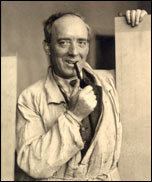Name George Bain | Role Artist | |
 | ||
Books Celtic Art: Spirals, Celtic Art: Notwork panels, Celtic Art: Zoomorphics, Celtic Art: Key Patterns, Celtic Art: Lettering | ||
George Bain (1881–1968), born in Scrabster in Caithness, Scotland, was an artist and art teacher who almost single-handedly revived interest in Celtic and Insular art.
In 1888 he left Scrabster with his family - they had intended to emigrate to Canada but, during a stop in Leith, the Bains met with a cousin who persuaded them to settle in Edinburgh instead. After leaving school, Bain joined a firm of printers in Edinburgh while, between the age of 15 and 21, studying art on a part time basis, attending the School of Applied Art and the Edinburgh School of Art. His first exhibited work as a painter was in 1900 at the Royal Scottish Academy.
In 1902 he obtained a scholarship to the Royal College of Art in London. When there, he found that a foundation of Classical Art still controlled the work of the college. In London, he supported himself by working as a freelance newspaper artist and as a book and magazine illustrator. In 1905 he returned to Edinburgh, continuing his career as a commercial artist while studying part time at the Royal Scottish Academy Life School.
Bain was the first artist to analyse and deconstruct the designs found on Pictish sculpture and metalwork, and on illuminated manuscripts such as the Book of Kells and the Lindisfarne Gospels. His book Celtic Art: The Methods of Construction was published in 1951. It had little impact at the time, but on its re-issue in 1971 it introduced a generation to Celtic knotwork, the Pictish stones, the Book of Kells and the Book of Durrow. As well as describing and illustrating over 200 historical examples, his book was notable for giving detailed instructions on creating similar interlace, spiral, and trumpet designs, and encouraging their use in craftwork.
Bain's monograph inspired the design for the cover of King Crimson's Discipline album; in later releases, it was replaced by a knotwork designed by Steve Ball, which has also been used the logo of Discipline Global Mobile and Guitar Craft, a music company and a musicians' association each founded by King Crimson's Robert Fripp. A Bain design was used to illustrate a rug by Quayle and Tranter, a carpet manufacturer based in Kidderminster, England.
His son Iain Bain, an engineer, later wrote two books - "Celtic Knotwork" and "Celtic Key Patterns" that were intended to simplify the creation of knotwork and keypattern designs by using grid lines and diagonals rather than the mathematical formulae applied by his father.
The majority of Bain's surviving artworks are curated by the Groam House Museum in Rosemarkie, Scotland.
